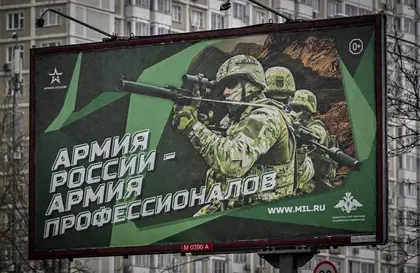A ten-day plan to take over Ukraine, signed off by President Vladimir Putin, has been published by a British defense and security think tank, revealing startling details of Moscow’s initial plan to conduct massive missile and airstrikes and murder officials.
The invasion plan was obtained by the British Army-linked think tank “the Royal United Services Institute for Defence and Security Studies” (RUSI), with allegedly only a small group of Russian officials being made aware of its existence.
- Access the newest Ukraine news items published today.
- Access the latest Ukraine news coverage for today.
JOIN US ON TELEGRAM
Follow our coverage of the war on the @Kyivpost_official.
The plan reveals that Putin originally hoped Ukraine would fall to Russia within ten days and would be annexed by August of this year.
Included in the documents is a “hit list” of Ukrainian politicians and officials, with Russian special services tasked with killing the Ukrainian leadership, whom the document predicts would “either flee or be captured as a result of the speed of the invasion.”
Names of individuals were divided into four categories: individuals whom the Kremlin wanted to be killed, those “in need of suppression and intimidation,” people to be encouraged to collaborate with Russia, and people whom Moscow had established as already being prepared to collaborate.
Filtration camps were also planned, with soldiers going door-to-door to assess or arrest the population of occupied territories. Russian teachers and other officials were then planned to “re-educate Ukrainians” via the use of propaganda. The FSB (Russia’s Federal Security Service) had also been tasked to capture and coerce regional governors and local authorities into cooperation.

Trump Makes 90 Day Foreign Aid Freeze – Ukraine Military Support Supposedly Untouched
Contrary to the “ten-day-plan” however, ten months into Russia’s brutal ongoing invasion, Kyiv still shows no signs of defeat, with Russian troops continuing to be pushed back from Russian-occupied towns and cities, particularly in the east of Ukraine.
Specific locations are also listed as targets for capture in the documents, including Ukrainian power stations, airfields, its central bank and parliament.
The invasion plan also details a plot to capture Ukraine’s nuclear power plants to control the country’s energy system and blackmail European neighbors with the risk of radiation pollution, RUSI said.
Russia currently controls Europe’s biggest nuclear power plant, based in the Enerhodar, Zaporizhzhia. The plant, which supplies around a fifth of Ukraine’s electricity, was surrounded by Russian forces on March 1, with the Director General of the International Atomic Energy Agency, Rafael Grossi, announcing the following day that Russian authorities were in control of the territory around the power plant.
On the night of March 3, a column of ten Russian armored vehicles and two tanks approached the power plant, capturing it after two hours of heavy fighting.
Since then, Enerhodar and Zaporizhzhia have experienced relentless Russian strikes, damaging local infrastructure and placing the nuclear power plant under grave risk.
With its initial plan evidently scrapped, and with Russia suffering numerous setbacks in its illegal invasion, Moscow shifted its position to conducting sham referendums in captured Ukrainian territories, including Zaporizhzhia and Kherson – the latter being recently liberated by Ukrainian troops in an another embarrassing blow for President Putin.
Missile strikes have also become a desperate tactic favored by the Kremlin, with President Zelensky confirming that between 30 and 40 percent of Ukrainian energy infrastructure had been impacted by drone and missile attacks since October.
Moscow’s failure to capture Ukraine has led to unrest in Russia, with protests erupting after President Putin was forced to announce on Sept. 1 the mobilization of 300,000 Russian reservists.
In a video widely circulated on social media platforms, Russian men from a small town in Yakutsk were filmed crying while hastily saying goodbye to their families, before heading off for brief military training.
As reported by British daily newspaper The Metro, many Russian men of conscription age found themselves being awoken in the middle of the night and handed their draft papers, with others given them when they arrived at work on the morning of Thursday, Sep. 22.
It is also alleged that men who do not technically qualify for mobilization were still being called up, with a 62-year-old trauma doctor alleging that military officials arrived at his clinic and informed him he had just four hours to pack his belongings and board a bus to a training center.
Tens of thousands of Russians fled their homeland upon hearing the announcement of imminent conscriptions, with queues stretching for miles along borders to neighboring countries.
Objections to conscription, mixed with the financial impact of sanctions against Russia, continues to place pressure on President Putin and the Kremlin.
Sergey Javoronkov, a senior researcher at the Gaidar Institute for Economic Policy, told CNN on Nov. 23 that the mood in Moscow was at boiling point due to “both the economic price and the dissatisfaction with the task [the invasion of Ukraine] not being solved.”
“We were supposed to win,” he said. “Officials promised to capture Kyiv in three days but, as we see, it turned out to be foolish.
“In his Feb. 24 speech, Vladimir Putin stated that the military operations would be conducted by professional troops only. But in September a partial mobilization was declared – also an unpopular measure; those who do not want to fight are being recruited.”
“It is a known effect: a short victorious war may provoke enthusiasm,” he added. “But if the war lasts endlessly and does not lead to the desired outcome, then comes disappointment.”
You can also highlight the text and press Ctrl + Enter










